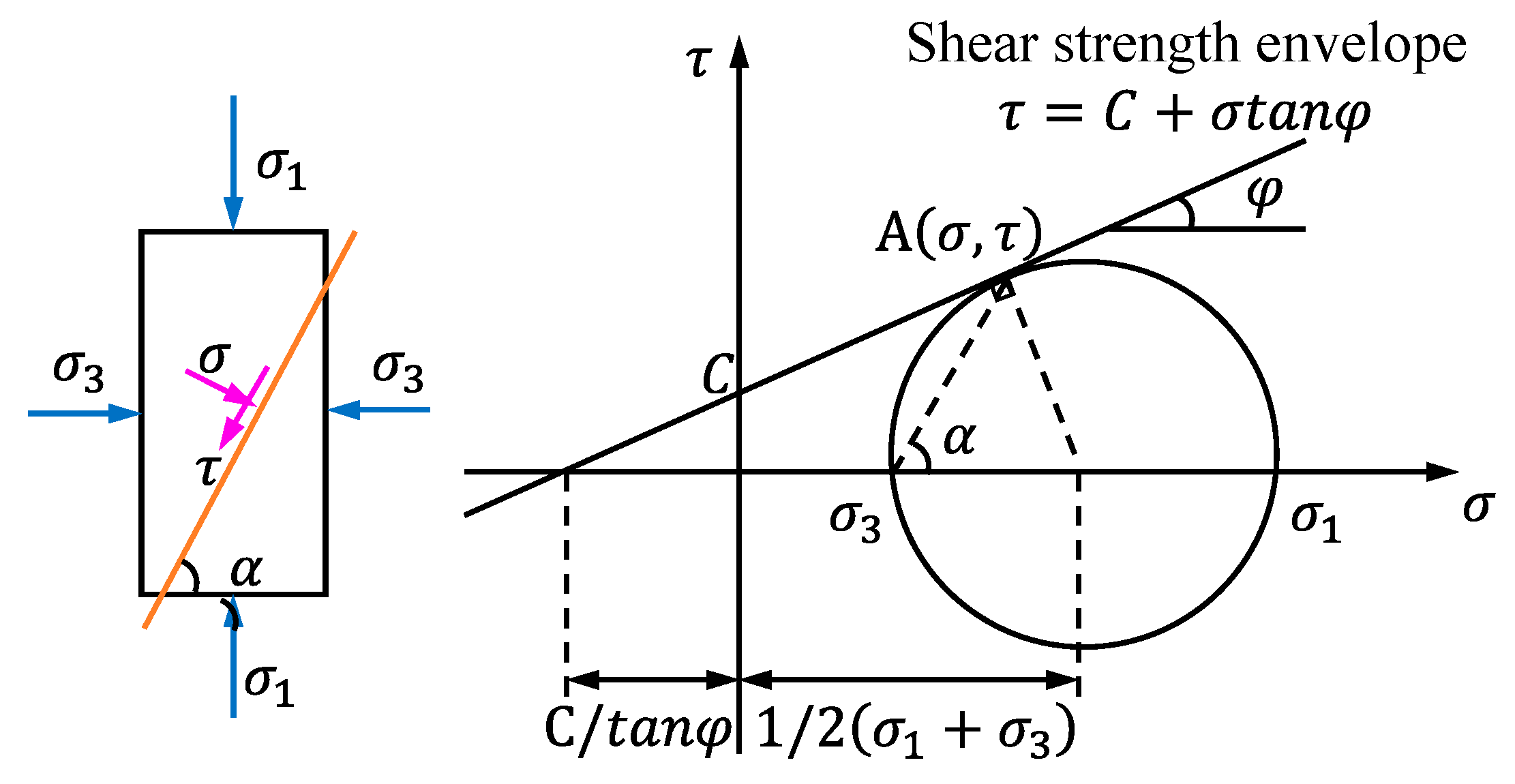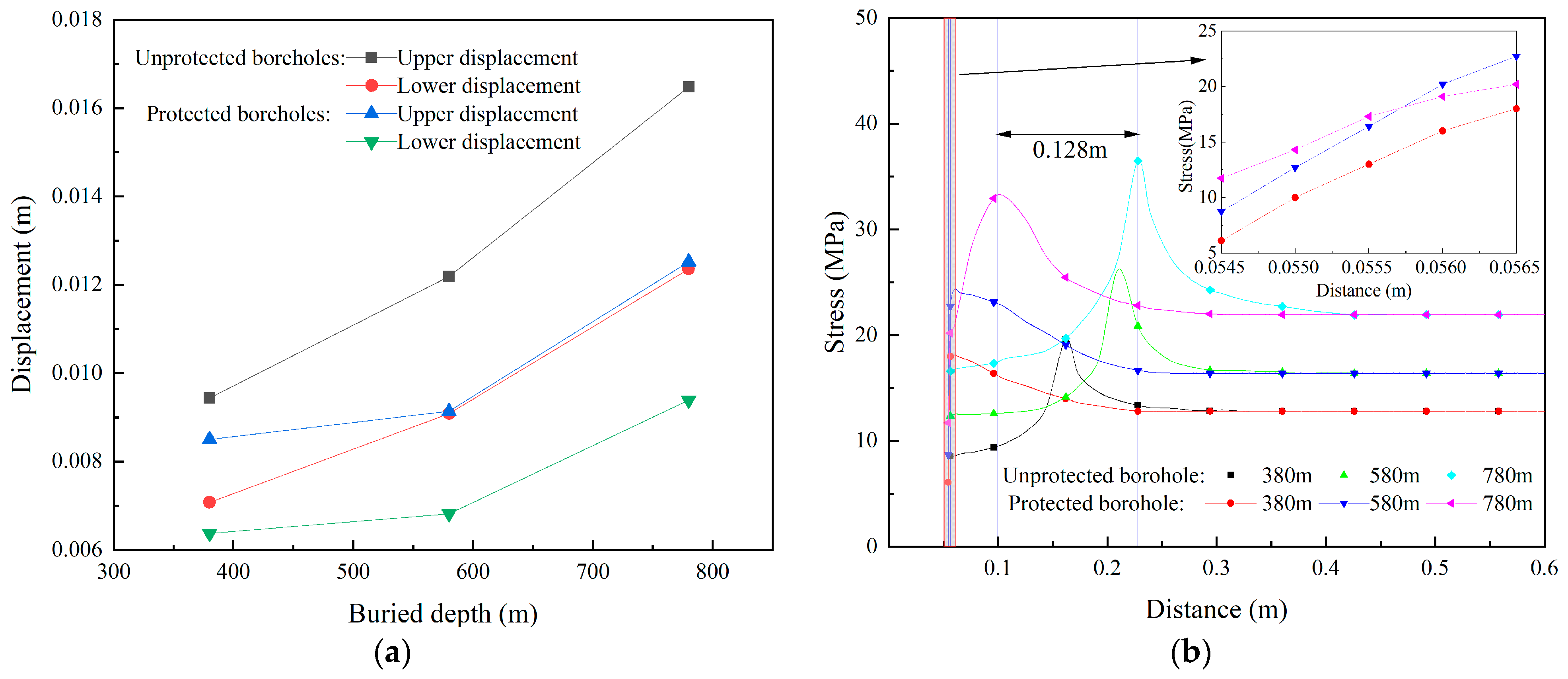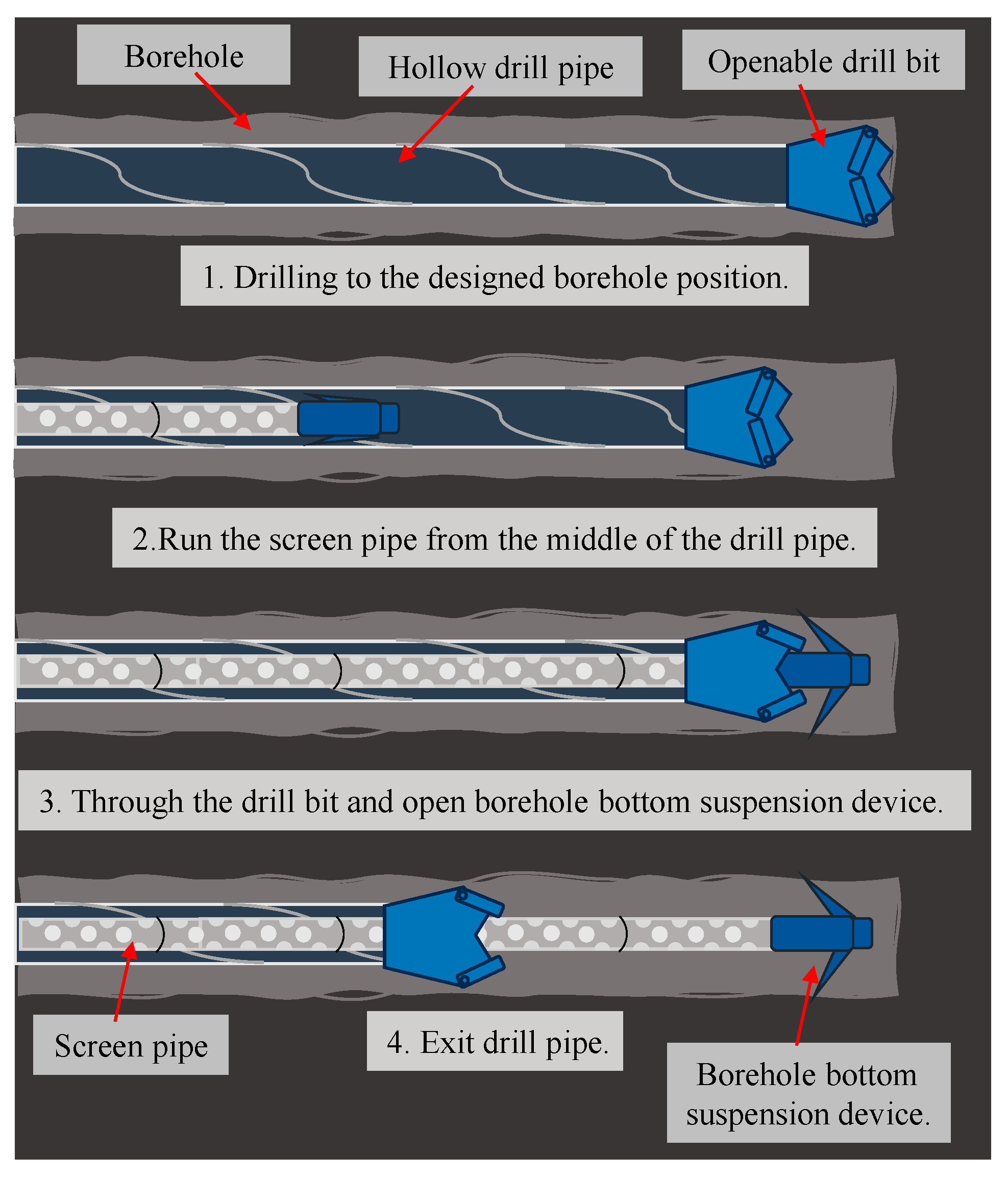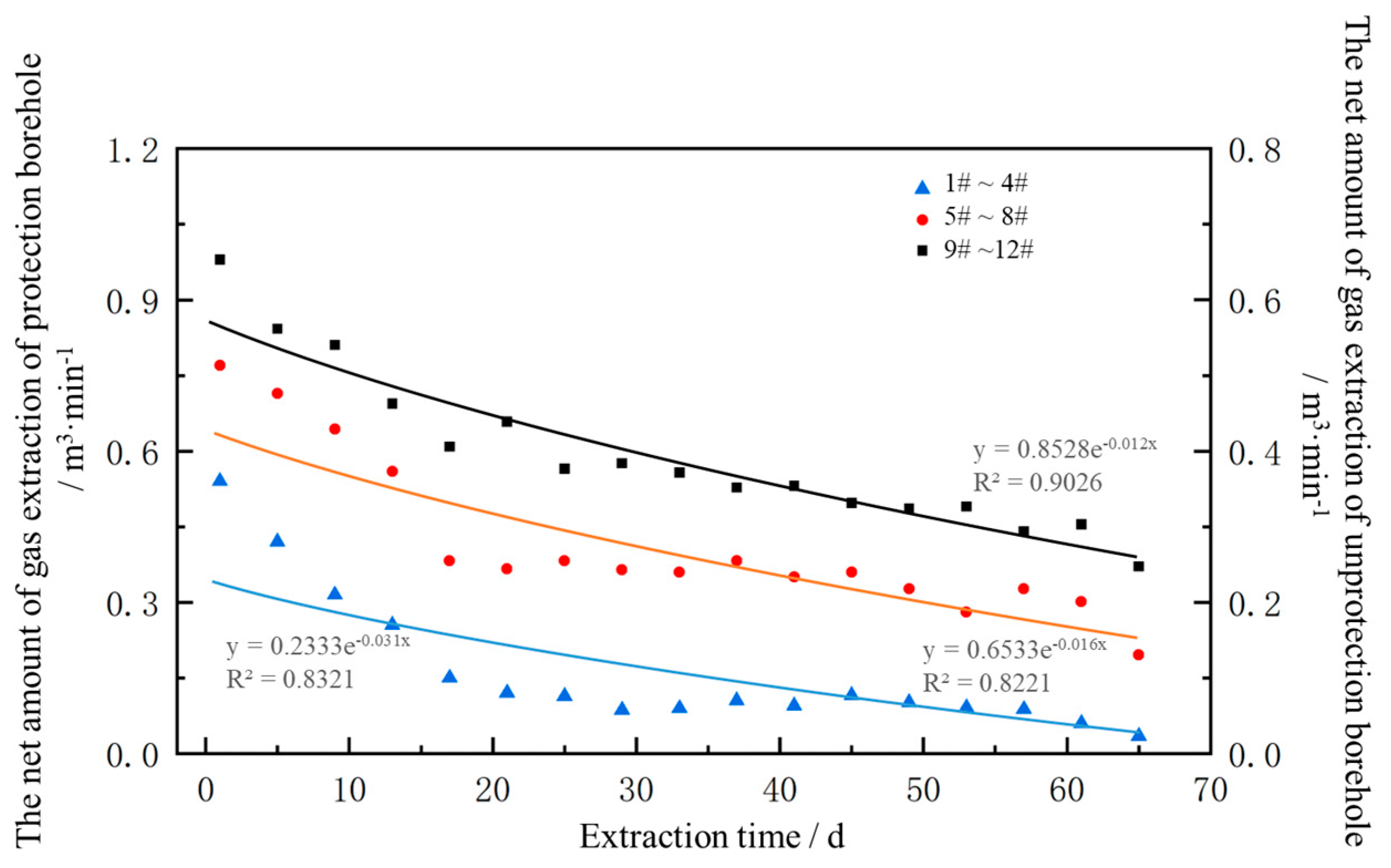Promoting Gas Extraction Technology with Screen Pipe for Long Borehole Protection in Soft Seam
Abstract
1. Introduction
2. Analysis and Methods
2.1. Deformation Failure Characteristics of the Long Borehole in Soft Coal Seams
2.2. Geometric Model Establishment and Simulation Scheme
3. Numerical Simulation Results and Discussions
3.1. Characteristics of Displacement and Stress Distribution around the Unprotected Borehole
3.2. Characteristics of Displacement and Stress Distribution around the Protected Borehole
3.3. Comprehensive Analysis
4. Field Testing on Gas Drainage with the Borehole Protection Technology
4.1. Technical Process and Construction Design
4.2. Investigation of Technical Pumping Effect
5. Conclusions
- This study analyzed the factors and characteristics contributing to the deformation and failure of long boreholes in soft coal seams, highlighting the impact of coal seam properties, engineering factors, stress conditions, and gas pressure.
- FLAC3D simulations were conducted to evaluate the stress, displacement, and plastic zones of protected and unprotected boreholes at various burial depths. The findings reveal that screen pipe support alters the stress distribution around the coal rock, significantly reducing deformation and displacement in soft coal seams, thereby prolonging the borehole service life and improving pumping efficiency.
- Field tests at Changping Coal Mine demonstrated that increasing borehole protection significantly boosts gas extraction efficiency. The flow attenuation coefficients of the protected boreholes were reduced by 48% and 61%, respectively, while gas extraction concentrations increased by over 1.8 times.
- This technology effectively mitigates the issue of immediate collapse upon drill withdrawal in soft coal seams. It prevents accidents such as borehole collapse, deformation, and plugging, ensuring longer service cycles and improving the efficiency of gas extraction.
Author Contributions
Funding
Data Availability Statement
Conflicts of Interest
References
- Liu, H.; Xiao, X.; Shu, Z. Elimination of Coal and Gas Outburst Dynamic Disasters in Dengfeng Coalfield through Gas Extraction Based on Extremely Thin Protective Coal Seam Mining. Adv. Civ. Eng. 2021, 2021, 8675060. [Google Scholar] [CrossRef]
- Dong, Q.; Wang, S.; Ma, J.; Lyu, S.; Lu, W. Methane Emission Characteristics and Model of CBM Wells. Front. Earth Sci. 2023, 10, 1037985. [Google Scholar] [CrossRef]
- Wang, F.; Zhang, C.; Liang, N. Gas Permeability Evolution Mechanism and Comprehensive Gas Drainage Technology for Thin Coal Seam Mining. Energies 2017, 10, 1382. [Google Scholar] [CrossRef]
- Xie, H.; Li, X.; Cai, J.; Wang, S.; Feng, C. Evolution of Fissures and Pressure Discharge of Gas Caused by Mining of the Upper Protective Layer of a Coal Seam. Sci. Rep. 2023, 13, 2561. [Google Scholar] [CrossRef]
- Zhao, X.; Huang, B.; Li, H.; Chen, S. Field Investigation of Multi-Stage Pulse Hydraulic Fracturing for Improving Permeability of Coal Seam in Directional Long Borehole in Underground Coal Mines. Environ. Earth Sci. 2023, 82, 519. [Google Scholar] [CrossRef]
- Pang, M.; Pan, H.; Ji, B.; Zhang, H.; Zhang, T. Experimental Investigation of Flow Regime Transition Characteristics of Fractured Coal Bodies around Gas Extraction Boreholes. Energy 2023, 270, 126758. [Google Scholar] [CrossRef]
- Guo, J.; Zhang, T.; Pan, H.; Wu, J. Experimental Investigation of the Creep Damage Evolution of Coal Rock around Gas Extraction Boreholes at Different Water Contents. PLoS ONE 2023, 18, e0278783. [Google Scholar] [CrossRef]
- Zhang, R.; Wang, J.; Liu, S.; Zhang, Z.; Ma, L.; Meng, W.; Wang, Z.; Huang, Y.; Liu, H.; Xu, F. Modeling and Durability Behavior of Erosion–Corrosion of Sand Control Screens in Deepwater Gas Wells. ACS Omega 2021, 6, 23943–23951. [Google Scholar] [CrossRef]
- Ren, Z.; Wang, H. Gas Migration around Large Diameter Borehole with the Protective Screen Pipe in Fractured Soft Coal Seam. ACS Omega 2023, 8, 26035–26044. [Google Scholar] [CrossRef]
- Qi, Q.; Jia, X.; Zhou, X.; Zhao, Y. Instability-Negative Pressure Loss Model of Gas Drainage Borehole and Prevention Technique: A Case Study. PLoS ONE 2020, 15, e0242719. [Google Scholar] [CrossRef]
- Geng, J.; Cao, L.; Zhong, C.; Wang, H.; Chen, B. Investigation of Dynamic Response of Drilling Parameters and Deformation Characteristics of Coal around Borehole during Multi-Stage Reaming in Tectonic Coal. Int. J. Rock Mech. Min. Sci. 2023, 170, 105540. [Google Scholar] [CrossRef]
- Zhang, X.-B.; Shen, S.-S.; Feng, X.-J.; Ming, Y.; Liu, J. Influence of Deformation and Instability of Borehole on Gas Extraction in Deep Mining Soft Coal Seam. Adv. Civ. Eng. 2021, 2021, e6689277. [Google Scholar] [CrossRef]
- Chen, Y.; Lu, A.; Mao, X.; Li, M.; Zhang, L. Nonlinear Dynamics Mechanism of Rock Burst Induced by the Instability of the Layer-Crack Plate Structure in the Coal Wall in Deep Coal Mining. Shock Vib. 2017, 2017, e4051967. [Google Scholar] [CrossRef]
- Song, Y.; Bao, R.; Shi, B. Experimental and Theoretical Study of the Time-Effect-Based Instability Characteristics of the Gas Drainage Borehole Sealing Section in a Soft Coal Seam. ACS Omega 2022, 7, 9303–9309. [Google Scholar] [CrossRef]
- Bao, R.; Shi, B.; Zhang, C. Research and Application of “Concentric Ring” Reinforcement and Sealing Technology for Gas Drainage Boreholes in Soft-Coal Seams. ACS Omega 2022, 7, 34763–34769. [Google Scholar] [CrossRef]
- Cheng, R.; Zhang, C.; Fan, F.; Duan, C.; Chen, Z. Research on Hole Collapse Monitoring Technology of Coal Seam Gas Extraction Boreholes. Sustainability 2023, 15, 10262. [Google Scholar] [CrossRef]
- Mosani, K.; Koushiki; Joshi, P. S.; Trivedi, J.V.; Bhanja, T. Gravitational Collapse of Scalar and Vector Fields. Phys. Rev. D 2023, 108, 044049. [Google Scholar] [CrossRef]
- Guo, H.; Wang, H.-Q.; Chen, S.-Q.; Wu, Z.-R. Cause Analysis and Prevention of Hole Collapse by Water Injection and Dust Removal in Qi Panjing Coal Mine. Geofluids 2020, 2020, e8814015. [Google Scholar] [CrossRef]
- Li, H.; Bai, H.; Wu, J.; Ma, Z.; Ma, K.; Wu, G.; Du, Y.; He, S. A Cascade Disaster Caused by Geological and Coupled Hydro-Mechanical Factors—Water Inrush Mechanism from Karst Collapse Column under Confining Pressure. Energies 2017, 10, 1938. [Google Scholar] [CrossRef]
- Kumar, R.; Das, A.J.; Mandal, P.K.; Bhattacharjee, R.; Tewari, S. Probabilistic Stability Analysis of Failed and Stable Cases of Coal Pillars. Int. J. Rock Mech. Min. Sci. 2021, 144, 104810. [Google Scholar] [CrossRef]
- Li, S. A Reflection on the Mohr Failure Criterion. Mech. Mater. 2020, 148, 103442. [Google Scholar] [CrossRef]
- Gu, J.; Chen, P. A Failure Criterion for Isotropic Materials Based on Mohr’s Failure Plane Theory. Mech. Res. Commun. 2018, 87, 1–6. [Google Scholar] [CrossRef]
- Tian, D.; Zheng, H. The Generalized Mohr-Coulomb Failure Criterion. Appl. Sci. 2023, 13, 5405. [Google Scholar] [CrossRef]
- Liang, J.-Y.; Li, Y.-M. A Failure Criterion Considering Stress Angle Effect. Rock Mech. Rock Eng. 2019, 52, 1257–1263. [Google Scholar] [CrossRef]
- Guo, J.; Zhang, Y.; Zhou, G.; Wen, H.; Wen, W.; Zhang, H.; Cui, H.; Zhang, Y. A Transverse Failure Criterion for Unidirectional Composites Based on the Puck Failure Surface Theory. Compos. Sci. Technol. 2023, 242, 110192. [Google Scholar] [CrossRef]
- Li, H.; Pel, L.; You, Z.; Smeulders, D. Stress-Dependent Mohr–Coulomb Shear Strength Parameters for Intact Rock. Sci. Rep. 2024, 14, 17454. [Google Scholar] [CrossRef] [PubMed]
- Wang, Z.; Sun, Y.; Li, Z.; Wang, Y.; You, Z. Multiphysics Responses of Coal Seam Gas Extraction with Borehole Sealed by Active Support Sealing Method and Its Applications. J. Nat. Gas Sci. Eng. 2022, 100, 104466. [Google Scholar] [CrossRef]
- Li, H.; Pel, L.; You, Z.; Smeulders, D. Stress-Dependent Instantaneous Cohesion and Friction Angle for the Mohr–Coulomb Criterion. Int. J. Mech. Sci. 2024, 283, 109652. [Google Scholar] [CrossRef]
- Wang, Z.; Hurter, S.; You, Z.; Honari, V.; Sun, Y.; Zhang, S. Influences of Negative Pressure on Air-Leakage of Coalseam Gas Extraction: Laboratory and CFD-DEM Simulations. J. Pet. Sci. Eng. 2021, 196, 107731. [Google Scholar] [CrossRef]










| Medium | Density (kg/m3) | Bulk Modulus (GPa) | Shear Modulus (GPa) | Cohesion (MPa) | Internal Friction Angle () | Tensile Strength (MPa) |
|---|---|---|---|---|---|---|
| Coal seam roof | 2650 | 8.05 | 5.98 | 15.3 | 45.4 | 11.9 |
| Coal seam | 1400 | 0.50 | 0.16 | 1.00 | 28.0 | 0.50 |
| Coal seam floor | 2800 | 1.60 | 1.20 | 3.47 | 43.0 | 4.96 |
| PVC screen pipe | 1380 | 3.00 | 1.20 | 0.08 | 34.0 | 65.0 |
| Borehole Number | Main Borehole Length/m | Protective Borehole Length/m | Protective Borehole Rate/% |
|---|---|---|---|
| 1 # | 248 | 0 | 0 |
| 2 # | 241 | 0 | 0 |
| 3 # | 206 | 0 | 0 |
| 4 # | 348 | 0 | 0 |
| 5 # | 372 | 241 | 64.78 |
| 6 # | 351 | 261 | 74.36 |
| 7 # | 315 | 227 | 72.06 |
| 8 # | 312 | 226 | 72.44 |
| 9 # | 261 | 243 | 93.10 |
| 10 # | 273 | 256 | 93.77 |
| 11 # | 319 | 304 | 95.30 |
| 12 # | 259 | 250 | 96.53 |
Disclaimer/Publisher’s Note: The statements, opinions and data contained in all publications are solely those of the individual author(s) and contributor(s) and not of MDPI and/or the editor(s). MDPI and/or the editor(s) disclaim responsibility for any injury to people or property resulting from any ideas, methods, instructions or products referred to in the content. |
© 2024 by the authors. Licensee MDPI, Basel, Switzerland. This article is an open access article distributed under the terms and conditions of the Creative Commons Attribution (CC BY) license (https://creativecommons.org/licenses/by/4.0/).
Share and Cite
Wang, L.; Wang, D.; Chen, X.; Min, R. Promoting Gas Extraction Technology with Screen Pipe for Long Borehole Protection in Soft Seam. Processes 2024, 12, 1996. https://doi.org/10.3390/pr12091996
Wang L, Wang D, Chen X, Min R. Promoting Gas Extraction Technology with Screen Pipe for Long Borehole Protection in Soft Seam. Processes. 2024; 12(9):1996. https://doi.org/10.3390/pr12091996
Chicago/Turabian StyleWang, Lin, Dezhang Wang, Xiangjun Chen, and Rui Min. 2024. "Promoting Gas Extraction Technology with Screen Pipe for Long Borehole Protection in Soft Seam" Processes 12, no. 9: 1996. https://doi.org/10.3390/pr12091996
APA StyleWang, L., Wang, D., Chen, X., & Min, R. (2024). Promoting Gas Extraction Technology with Screen Pipe for Long Borehole Protection in Soft Seam. Processes, 12(9), 1996. https://doi.org/10.3390/pr12091996





